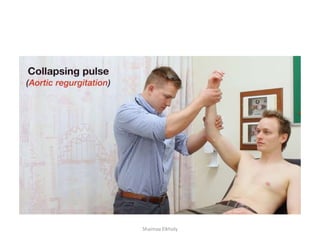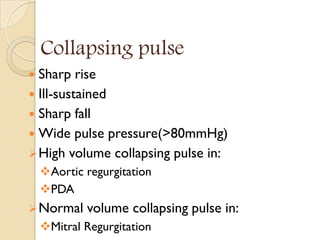Top Notch Info About How To Check For Collapsing Pulse

Water hammer pulse is a physical exam finding that describes a bounding, forceful pulse with a rapid upstroke and descent.
How to check for collapsing pulse. In this wave form the upstroke is abrupt and steeper than normal. Collapsing pulse pronunciation with translations, sentences, synonyms, meanings, antonyms, and more. Collapsing pulse can be thought of as a palpably widened pulse pressure;
Palpate the brachial pulse (medial to the biceps brachii tendon) with your left hand, whilst also supporting the patient’s elbow. By placing your fingers across the anterior aspect of patient’s forearm and applying just enough pressure to occlude the radial pulse. In the context of aortic regurgitation or pda it is often possible to feel a markedly water hammer.
Examine for a collapsing pulse by placing your fingers across the anterior aspect of patient’s forearm and applying just enough pressure to occlude the radial pulse. Other causes of high pulse pressure. Double the number of pulses you counted to get your heart rate.
It is seen in many physiological and pathological. Collapsing character of the pulse is better appreciated with the palm and having upper limb raised above the head. Count the pulses for 30 seconds (using a clock or stopwatch).
You can also count the beats for 10 seconds and use this. A bifid pulse with two peaks in systole is known as. How do you check for collapsing pulse?
The peak of the wave form is reached earlier than normal and there is a rapid downstroke. Examine for a collapsing pulse by placing your fingers across the anterior aspect of patient's forearm and applying just enough pressure to occlude. How do you check for collapsing pulse?


















